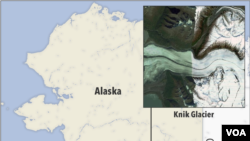Fossils from tiny baby dinosaurs discovered in northernmost Alaska offer strong evidence that the prehistoric creatures lived year-round in the Arctic and were likely warm-blooded, according to a study published on Thursday in the journal Current Biology.
The fossils are from at least seven types of dinosaurs just hatched or still in their eggs about 70 million years ago. Researchers have never found evidence of dinosaur nests so far north, said lead author Pat Druckenmiller, director of the University of Alaska Museum of the North.
The find helps upend past assumptions of dinosaurs as giant cold-blooded reptiles.
"If they reproduced, then they over-wintered there. If they overwintered there, they had to deal with conditions that we don't usually associate with dinosaurs, like freezing conditions and snow," Druckenmiller said.
To survive dark Arctic winters, those dinosaurs could not have basked in the sun to warm their bodies, as lizards do, he said.
"At least these groups had endothermy," he said, using the term for the ability of animals to warm their bodies through internal functions. "They had a degree of warm-bloodedness."
The discovery site is a steep bluff on the Colville River on Alaska's North Slope, at latitude 70 and about 400 kilometers north of the Arctic Circle. In the Cretaceous period, when North America was positioned differently, it was even farther north, at latitude 80 or 85, Druckenmiller said.
The region was much warmer then than Alaska's North Slope is now but hardly tropical. From remnants of ancient plants, scientists calculate the average annual temperature at about 6 degrees Celsius – similar to Juneau, Alaska – meaning below-freezing winters with snow, Druckenmiller said.
While Alaska's North Slope endures two months of total winter darkness now, during the Cretaceous period it was in total darkness for up to four months a year, he said.
Finding the tiny bones and teeth, some the size of a pinhead, was laborious, Druckenmiller said. They were identified through microscopic examination after being sifted out multiple times from sediments collected in expeditions stretching back decades, he said.
"I liken it to gold panning. It's a very slow process," he said.
The discovery site, called the Prince Creek Formation, has proved crucial to modern understanding of the ancient creatures.
The first dinosaur discovery was made there in the 1960s by a petroleum geologist. Subsequent expeditions found previously unknown dinosaur species. Over time, evidence of year-round Arctic occupation has mounted.
At the same formation, other scientists found a jawbone from a baby dromaeosaurid, detailed in a study published last year in the journal PLOS ONE. That meat-eating dinosaur would have been the size of a small puppy and incapable of long-distance migration, said co-author Tony Fiorillo, a Southern Methodist University paleontologist.
The new study about nesting dinosaurs strengthens the growing realization that dinosaurs lived full-time in the Arctic and thus could not be cold-blooded, Fiorillo said.
"This new study broadens the conversation about year-round dinosaurs in the Arctic. It didn't invent the conversation," he said.












